Sustainability is no longer a mere buzzword – it’s an expectation. According to a recent study, more than 85% of U.S. consumers consider it important for businesses to act responsibly with regard to society and the environment. These customers are increasingly conscious of the environmental and social impact of the brands they support, pushing companies to prioritize sustainable practices in every facet of their operations, including supply chain management. But what exactly does it mean to have a sustainable supply chain? It’s more than just reducing carbon emissions; it also encompasses responsible sourcing, ethical labor practices and economic viability.
Building a sustainable supply chain is a journey that can start with small, incremental changes. Whether it’s reducing waste, optimizing transportation or choosing more eco-friendly suppliers, every step counts. Over time, these efforts can lead to significant progress, with the ultimate long-term goal potentially being Net Zero. However, the emphasis should be on commitment – showing stakeholders that you are taking action, no matter how small, and continuously striving towards a more sustainable future. This article will explore the key elements of a sustainable supply chain and provide actionable steps to help your business start or advance its sustainability journey.
What is a sustainable supply chain?
A sustainable supply chain is a holistic approach to managing the flow of goods and services that balances environmental, social and economic considerations. At its core, sustainability in the supply chain involves minimizing the environmental impact, promoting social responsibility and ensuring economic viability. For example, this could mean reducing carbon emissions by optimizing logistics routes, minimizing waste through more efficient manufacturing processes or using renewable energy sources.
Environmental impact is often the most visible aspect of a sustainable supply chain. Companies aim to reduce their carbon footprint, lower waste production and conserve resources. This may involve sourcing materials from suppliers prioritizing sustainable practices or investing in energy-efficient technologies. Social responsibility, another crucial component, encompasses fair labor practices, ethical sourcing and positively impacting communities. A company might ensure that its suppliers adhere to labor laws, provide fair wages and work in safe conditions, reflecting a commitment to human rights and community well-being.
Economic viability ensures that sustainability efforts are not only good for the planet but also make financial sense. Implementing sustainable practices can lead to cost savings in the long run through improved efficiency, reduced waste and enhanced brand reputation, attracting more customers and investors.
Sustainability in supply chain management is about long-term thinking – balancing today’s needs with the future’s well-being. By integrating these elements, businesses can create a supply chain that is resilient, responsible and ready for tomorrow's challenges.
Benefits of a sustainable supply chain
A sustainable supply chain offers numerous benefits. Environmentally, it helps reduce carbon emissions and conserves natural resources. For instance, companies that optimize their transportation networks or switch to renewable energy sources significantly lower their environmental footprint, contributing to a healthier planet.
Economically, sustainable supply chains can lead to substantial cost savings through efficiency improvements, such as reducing waste or streamlining operations. Additionally, embracing sustainability enhances brand reputation, which can boost customer loyalty. Consumers today are more likely to support brands that demonstrate a commitment to sustainability, creating a competitive advantage in the marketplace.
Socially, a sustainable supply chain positively impacts communities and improves employee satisfaction. Companies that prioritize fair labor practices and ethical sourcing contribute to societal well-being and foster a more motivated and loyal workforce. Employees are increasingly seeking to work for organizations that align with their values, making sustainability a key factor in attracting and retaining top talent.
By integrating sustainability into their supply chains, businesses can achieve a triple win: benefiting the environment, enhancing profitability and contributing positively to society.
Challenges in building a sustainable supply chain
Building a sustainable supply chain comes with its share of challenges, the first being cost implications. Implementing sustainable practices often requires an initial investment in new technologies, materials or processes. For example, switching to renewable energy or sourcing eco-friendly materials can be expensive upfront, requiring careful long-term financial planning to ensure these investments pay off over time.
Another hurdle is the complexity of managing a sustainable supply chain. Companies must coordinate with multiple stakeholders, including suppliers, regulators and customers, to ensure that sustainable practices are adhered to throughout the supply chain. This may require negotiating with suppliers to adopt greener practices or navigating the varying regulations across different regions.
There’s also the risk of supply chain disruption. Transitioning to sustainable practices can lead to temporary disruptions, such as delays in sourcing materials or unexpected challenges in production. Companies must be prepared to manage these risks while staying committed to their sustainability goals. Despite these challenges, the long-term benefits make the effort worthwhile.
Key strategies for building a sustainable supply chain
Building a sustainable supply chain is a strategic process that requires a thoughtful approach and commitment to continuous improvement. Here are key strategies to guide you through this transformation:
- Assess your current supply chain: The first step is to conduct a thorough sustainability audit of your existing supply chain. Evaluate each stage of your operations to identify areas where environmental, social or economic improvements can be made. Look for inefficiencies, such as excessive waste or energy use, and assess the ethical standards of your suppliers. This assessment provides a clear baseline from which to develop your sustainability initiatives.
- Set clear sustainability goals: Well-defined sustainability goals are crucial for guiding your efforts. Align your objectives with global standards, such as the United Nations Sustainable Development Goals (UN SDGs), to ensure they are comprehensive and impactful. Set both short-term and long-term targets, such as reducing carbon emissions by a specific percentage within five years or achieving zero waste by a particular date. These goals should be ambitious yet attainable, providing a clear roadmap for your sustainability journey.
- Engage stakeholders: Collaborate with all stakeholders, including suppliers, partners and customers. Engage your suppliers in discussions about adopting sustainable practices, and work together to find mutually beneficial solutions. Transparency and accountability are key; ensure that all parties are committed to the same sustainability standards and are willing to report progress regularly.
- Implement sustainable practices: Start by adopting green technologies, such as energy-efficient machinery or renewable energy sources. Optimize logistics and transportation to reduce fuel consumption and lower your carbon footprint. For example, locating your 3PL fulfillment operations closer to your customers can reduce the distance products are transported, reducing emissions and fuel consumption.
- Monitor and report progress: Sustainability is an ongoing process that requires regular monitoring and adjustment. Create a system for tracking key performance indicators (KPIs) related to your sustainability goals and produce regular reports to evaluate progress. Use these insights to adjust your strategies, addressing any challenges that arise and continuously improving your supply chain's sustainability.
Implement sustainable strategies today
Whether you choose to use more sustainable packaging or invest in more energy efficient equipment, becoming a more sustainable brand is essential for long-term success, as it benefits the environment and enhances brand reputation and customer loyalty. By integrating sustainability into your operations, you position your business to meet growing consumer expectations and contribute positively to society. Start your sustainability journey today by partnering with Cart.com's 3PL network of nationwide fulfillment centers to get closer to your customers, or invest in our transportation management system software to optimize shipping and reduce your carbon footprint.
Subscribe to our emails for the latest industry insights!
By entering your email, you agree to receive marketing emails from Cart.com




.png?width=1940&height=180&name=better%20software%20(1).png)



